Chianti
A Chianti wine (/kiˈænti/, also US: /-ˈɑːn-/, Italian: [ˈkjanti]) is any wine produced in the Chianti region of central Tuscany. It was historically associated with a squat bottle enclosed in a straw basket, called a fiasco ("flask"; pl. fiaschi). However, the fiasco is only used by a few makers of the wine as most Chianti is now bottled in more standard shaped wine bottles. Baron Bettino Ricasoli (later Prime Minister of the Kingdom of Italy) created the Chianti recipe of 70% Sangiovese, 15% Canaiolo and 15% Malvasia bianca in the middle of the 19th century.[1]
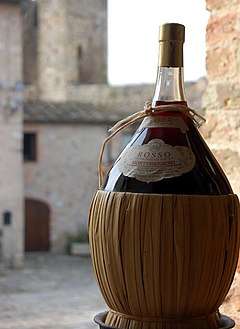
The first definition of a wine-area called Chianti was made in 1716. It described the area near the villages of Gaiole, Castellina and Radda; the so-called Lega del Chianti and later Provincia del Chianti (Chianti province). In 1932 the Chianti area was completely re-drawn and divided in seven sub-areas: Classico, Colli Aretini, Colli Fiorentini, Colline Pisane, Colli Senesi, Montalbano and Rùfina. Most of the villages that in 1932 were suddenly included in the new Chianti Classico area added in Chianti to their name-such as Greve in Chianti which amended its name in 1972. Wines labelled "Chianti Classico" come from the biggest sub-area of Chianti, that includes the original Chianti heartland. Only Chianti from this sub-zone may boast the black rooster seal (known in Italian as a gallo nero) on the neck of the bottle, which indicates that the producer of the wine is a member of the Chianti Classico Consortium, the local association of producers.[2][3] Other variants, with the exception of Rufina from the north-east side of Florence and Montalbano in the south of Pistoia, originate in the respective named provinces: Siena for the Colli Senesi, Florence for the Colli Fiorentini, Arezzo for the Colli Aretini and Pisa for the Colline Pisane. In 1996 part of the Colli Fiorentini sub-area was renamed Montespertoli.
During the 1970s producers started to reduce the quantity of white grapes in Chianti. In 1995 it became legal to produce a Chianti with 100% Sangiovese. For a wine to retain the name of Chianti, it must be produced with at least 80% Sangiovese grapes.[4] Aged Chianti (38 months instead of 4–7) may be labelled as Riserva. Chianti that meets more stringent requirements (lower yield, higher alcohol content and dry extract) may be labelled as Chianti Superiore, although Chianti from the "Classico" sub-area is not allowed in any event to be labelled as "Superiore".
History

The earliest documentation of a "Chianti wine" dates back to the 13th century when viticulture was known to flourish in the "Chianti Mountains" around Florence. The merchants in the nearby townships of Castellina, Gaiole and Radda formed the Lega del Chianti (League of Chianti) to produce and promote the local wine. In 1398, records note that the earliest incarnation of Chianti was as a white wine.[1] In 1716 Cosimo III de' Medici, Grand Duke of Tuscany issued an edict legislating that the three villages of the Lega del Chianti (Castellina in Chianti, Gaiole in Chianti and Radda in Chianti) as well as the village of Greve and a 3.2-kilometre-long stretch (2-mile) of hillside north of Greve near Spedaluzzo as the only officially recognised producers of Chianti. This delineation existed until July 1932, when the Italian government expanded the Chianti zone to include the outlying areas of Barberino Val d'Elsa, Chiocchio, Robbiano, San Casciano in Val di Pesa and Strada. Subsequent expansions in 1967 would eventually bring the Chianti zone to cover a very large area all over central Tuscany.
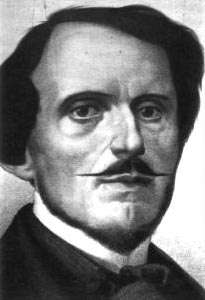
By the 18th century, Chianti was widely recognised as a red wine, but the exact composition and grape varieties used to make Chianti at this point is unknown. Ampelographers find clues about which grape varieties were popular at the time in the writings of Italian writer Cosimo Villifranchi who noted that Canaiolo was widely planted variety in the area along with Sangiovese, Mammolo and Marzemino.[1] It was not until the work of the Italian statesman Bettino Ricasoli that the modern "Chianti recipe" as a Sangiovese-based wine would take shape.[5] Prior to Ricasoli, Canaiolo was emerging as the dominant variety in the Chianti blend with Sangiovese and Malvasia playing supporting roles. In the mid-19th century, Ricasoli developed a recipe for Chianti that was based primarily on Sangiovese. His recipe called for 70% Sangiovese, 15% Canaiolo, 10% Malvasia (later amended to include Trebbiano) and 5% other local red varieties. In 1967, the Denominazione di origine controllata (DOC) regulation set by the Italian government firmly established the "Ricasoli formula" of a Sangiovese-based blend with 10–30% Malvasia and Trebbiano.[6]
The late 19th century saw a period of economic and political upheaval. First came oidium and then the phylloxera epidemic would take its toll on the vineyards of Chianti just as they had ravaged vineyards across the rest of Europe. The chaos and poverty following the Risorgimento heralded the beginning of the Italian diaspora that would take Italian vineyard workers and winemakers abroad as immigrants to new lands.[5] Those that stayed behind and replanted choose high-yielding varieties like Trebbiano and Sangiovese clones such as the Sangiovese di Romagna from the nearby Romagna region. Following the Second World War, the general trend in the world wine market for cheap, easy-drinking wine saw a brief boom for the region. With over-cropping and an emphasis on quantity over quality, the reputation of Chianti among consumers eventually plummeted. By the 1950s, Trebbiano (which is known for its neutral flavours) made up to 30% of many mass-market Chiantis.[7] By the late 20th century, Chianti was often associated with basic Chianti sold in a squat bottle enclosed in a straw basket, called a fiasco. However, during the same period, a group of ambitious producers began working outside the boundaries of DOC regulations to make what they believed would be a higher quality wine. These wines eventually became known as the "Super Tuscans".[1]
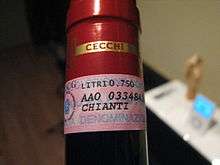
Many of the producers behind the Super Tuscan movement were originally Chianti producers who were rebelling against what they felt were antiquated DOC regulations. Some of these producers wanted to make Chiantis that were 100% varietal Sangiovese. Others wanted the flexibility to experiment with blending French grape varieties such as Cabernet Sauvignon and Merlot or to not be required to blend in any white grape varieties. The late 20th century saw a flurry of creativity and innovation in the Chianti zones as producers experimented with new grape varieties and introduced modern wine-making techniques such as the use of new oak barrels. The prices and wine ratings of some Super Tuscans would regularly eclipse those of DOC sanctioned Chiantis. The success of the Super Tuscans encouraged government officials to reconsider the DOC regulations in order to bring some of these wines back into the fold labelled as Chianti.[6]
Chianti subregions

The Chianti region covers a vast area of Tuscany and includes within its boundaries several overlapping Denominazione di origine controllata (DOC) and Denominazione di Origine Controllata e Garantita (DOCG) regions. Other well known Sangiovese-based Tuscan wines such as Brunello di Montalcino and Vino Nobile di Montepulciano could be bottled and labelled under the most basic designation of "Chianti" if their producers chose to do so.[8] Within the collective Chianti region more than 8 million cases of wines classified as DOC level or above are produced each year. Today, most Chianti falls under two major designations of Chianti DOCG, which includes basic level Chianti, as well as that from seven designated sub-zones, and Chianti Classico DOCG.[4] Together, these two Chianti zones produce the largest volume of DOC/G wines in Italy.[6]
The Chianti DOCG covers all the Chianti wine and includes a large stretch of land encompassing the western reaches of the province of Pisa near the coast of the Tyrrhenian Sea, the Florentine hills in the province of Florence to the north, to the province of Arezzo in the east and the Siena hills to the south. Within this regions are vineyards that overlap the DOCG regions of Brunello di Montalcino, Vino Nobile di Montepulciano and Vernaccia di San Gimignano. Any Sangiovese-based wine made according to the Chianti guidelines from these vineyards can be labelled and marked under the basic Chianti DOCG should the producer wish to use the designation.[4]
Within the Chianti DOCG there are eight defined sub-zones that are permitted to affix their name to the wine label.[8] Wines that are labelled as simply Chianti are made either from a blend from these sub-zones or include grapes from peripheral areas not within the boundaries of a sub-zone. The sub-zones are (clockwise from the north): the Colli Fiorentini which is located south of the city of Florence; Chianti Rufina in the northeastern part of the zone located around the commune of Rufina; Classico in the centre of Chianti, across the provinces of Florence and Siena; Colli Aretini in the Arezzo province to the east; Colli Senesi south of Chianti Classico in the Siena hills, which is the largest of the sub-zones and includes the Brunello di Montalcino and Vino Nobile di Montepulciano areas; Colline Pisane, the westernmost sub-zone in the province of Pisa; Montespertoli located within the Colli Fiorentini around the commune of Montespertoli; Montalbano in the north-west part of the zone which includes the Carmignano DOCG.[4] As of 2006, there were 318 hectares (786 acres) under production in Montalbano, 905 ha (2,236 acres) in the Colli Fiorentini, 57 ha (140 acres) in Montespertoli, 740 ha (1,840 acres) in Rufina, 3,550 ha (8,780 acres) in the Colli Senesi, 150 ha (380 acres) in Colline Pisane, 649 ha (1,603 acres) in the Colli Aretini, and an additional 10,324 ha (25,511 acres) in the peripheral areas that do not fall within one of the sub-zone classifications. Wines produced from these vineyards are labelled simply "Chianti".[1]
Chianti Classico
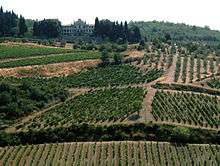
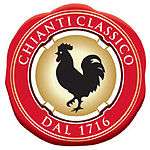
The original area dictated by the edict of Cosimo III de' Medici would eventually be considered the heart of the modern "Chianti Classico" subregion.[6][6] As of 2006, there were 7,140 ha (17,640 acres) of vineyards in the Chianti Classico subregion.[1] The Chianti Classico subregion covers an area of approximate 260 km2 (100 square miles) between the city of Florence to the north and Siena to the south. The four communes of Castellina in Chianti, Gaiole in Chianti, Greve in Chianti and Radda in Chianti are located entirely within the boundaries of the Classico area with parts of Barberino Val d'Elsa, San Casciano in Val di Pesa and Tavarnelle Val di Pesa in the province of Florence as well as Castelnuovo Berardenga and Poggibonsi in the province of Siena included within the permitted boundaries of Chianti Classico. The soil and geography of this subregion can be quite varied, with altitudes ranging from 250 to 610 m (820 to 2,000 feet), and rolling hills producing differing macroclimates. There are two main soil types in the area: a weathered sandstone known as alberese and a bluish-gray chalky marlstone known as galestro.[6] The soil in the north is richer and more fertile with more galestro, with the soil gradually becoming harder and stonier with more albarese in the south. In the north, the Arno River can have an influence on the climate, keeping the temperatures slightly cooler, an influence that diminishes further south in the warmer Classico territory towards Castelnuovo Berardenga.[4]
Chianti Classico are premium Chianti wines that tend to be medium-bodied with firm tannins and medium-high to high acidity. Floral, cherry and light nutty notes are characteristic aromas with the wines expressing more notes on the mid-palate and finish than at the front of the mouth. As with Bordeaux, the different zones of Chianti Classico have unique characteristics that can be exemplified and perceived in some wines from those areas. According to Master of Wine Mary Ewing-Mulligan, Chianti Classico wines from the Castellina area tend to have a very delicate aroma and flavour, Castelnuovo Berardegna wines tend to be the most ripe and richest tasting, wines from Gaiole tend to have been characterised by their structure and firm tannins while wines from the Greve area tend to have very concentrated flavours.[4]
The production of Chianti Classico is realised under the supervision of Consorzio del Vino Chianti Classico, a union of producers in the Chianti Classico subregion. The Consorzio was founded with the aim of promoting the wines of the subregion, improving quality and preventing wine fraud. Since the 1980s, the foundation has sponsored extensive research into the viticultural and winemaking practice of the Chianti Classico area, particularly in the area of clonal research. In the last three decades, more than 50% of the vineyards in the Chianti Classico subregion have been replanted with improved Sangiovese clones and modern vineyard techniques as part of the Consorzio Chianti Classico's project "Chianti 2000".[6]
In 2014 a new category of Chianti Classico was introduced: Chianti Classico Gran Selezione.[9] Gran Selezione is made exclusively from a winery’s own grapes grown according to stricter regulations compared to regular Chianti Classico.[9] Gran Selezione is granted to a Chianti Classico after it passes a suitability test conducted by authorised laboratories and after it is approved by a special tasting committee.[9] The creation of the Chianti Classico Gran Selezione DOCG has been criticized, with some describing it as being "Needless; an extra layer of confusion created by marketing people hoping to help Chianti Classico out of a sales crisis."[10][11]
Greater Chianti region
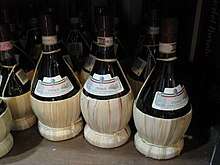
Outside of the Chianti Classico area, the wines of the Chianti sub-zone of Rufina are among the most widely recognised and exported from the Chianti region. Located in the Arno valley near the town of Pontassieve, the Rufina region includes much area in the Pomino region, an area that has a long history of wine production. The area is noted for the cool climate of its elevated vineyards located up to 900 m (2,950 feet). The vineyard soils of the area are predominantly marl and chalk. The Florentine merchant families of the Antinori and Frescobaldi own the majority of the vineyards in Rufina. Chianti from the Rufina area is characterised by its multi-layered complexity and elegance.[6]
The Colli Fiorentini subregion has seen an influx of activity and new vineyard development in recent years as wealthy Florentine business people move to the country to plant vineyards and open wineries. Many foreign "flying winemakers" have had a hand in this development, bringing global viticulture and wine-making techniques to the Colli Fiorentini. Located in the hills between the Chianti Classico area and Arno valley, the wines of the Colli Fiorentini vary widely depending on producer, but tend to have a simple structure with strong character and fruit notes.[6] The Montespertoli sub-zone was part of the Colli Fiorentini sub-zone until 2002 when it became its own tiny enclave.[1]
The Montalbano subregion is located in the shadow of the Carmignano DOCG, with much of the best Sangiovese going to that wine. A similar situation exists in the Colli Senesi which includes the well known DOCG region of Vino Nobile di Montepulciano. Both regions rarely appear on wine labels that are exported out of Tuscany. The Colli Pisane area produces typical Chiantis with the lightest body and color. The Colli Aretini is a relatively new and emerging area that has seen an influx of investment and new winemaking in recent years.[6]
Grapes and classification
Since 1996 the blend for Chianti and Chianti Classico has been 75–100% Sangiovese, up to 10% Canaiolo and up to 20% of any other approved red grape variety such as Cabernet Sauvignon, Merlot or Syrah. Since 2006, the use of white grape varieties such as Malvasia and Trebbiano have been prohibited in Chianti Classico.[12] Chianti Classico must have a minimum alcohol level of at least 12% with a minimum of 7 months aging in oak, while Chianti Classicos labeled riserva must be aged at least 24 months at the winery, with a minimum alcohol level of at least 12.5%.[4] The harvest yields for Chianti Classico are restricted to no more than 7.5 t/ha (3 tonnes per acre). For basic Chianti, the minimum alcohol level is 11.5% with yields restricted to 9 t/ha (4 tonnes per acre).[6][13]
The aging for basic Chianti DOCG is much less stringent with most varieties allowed to be released to the market on 1 March following the vintage year. The sub-zones of Colli Fiorentini, Montespertoli and Rufina must be aged for a further three months and not released until 1 June. All Chianti Classicos must be held back until 1 October in the year following the vintage.[1]
| Comparative table of Chianti laws of production[14] | ||||||||||
|---|---|---|---|---|---|---|---|---|---|---|
| normal | Classico | Colli Aretini | Colli Fiorentini | Colli Senesi | Colline Pisane | Montalbano | Montespertoli | Rùfina | Superiore | |
| Max. grape prod. (t/ha) | 9.0 | 7.5 | 8.0 | 8.0 | 8.0 | 8.0 | 8.0 | 8.0 | 8.0 | 7.5 |
| Max. grape prod. (kg/vine) | 4.0 | 3.0 | 4.0 | 4.0 | 4.0 | 4.0 | 4.0 | 4.0 | 4.0 | 2.2 |
| Min. vines/ha | 3,300 | 3,350 | 3,300 | 3,300 | 3,300 | 3,300 | 3,300 | 3,300 | 3,300 | 4,000 |
| Min. age of vineyards (years) | 3 | 4 | 4 | 4 | 4 | 4 | 4 | 4 | 4 | 4 |
| Min. wine dry extract (g/l) | 19 | 23 | 21 | 21 | 21 | 21 | 21 | 21 | 21 | 22 |
| Min. alcohol cont. (%) | 11.5 | 12.0 | 11.5 | 12.0 | 11.5 | 11.5 | 11.5 | 12.0 | 12.0 | 12.0 |
| Min. aging (months) | 3 | 10 | 3 | 9 | 3 | 3 | 3 | 6 | 9 | 9 |
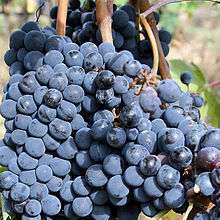
Jancis Robinson notes that Chianti is sometimes called the "Bordeaux of Italy" but the structure of the wines is very different from any French wine.[12] The flexibility in the blending recipe for Chianti accounts for some of the variability in styles among Chiantis. Lighter bodied styles will generally have a higher proportion of white grape varieties blended in, while Chiantis that have only red grape varieties will be fuller and richer. While only 15% of Cabernet Sauvignon is permitted in the blend, the nature of the grape variety can have a dominant personality in the Chianti blend and be a strong influence in the wine.[4]
Chianti Classico wines are characterised in their youth by their predominantly floral and cinnamon spicy bouquet. As the wine ages, aromas of tobacco and leather can emerge. Chiantis tend to have medium-high acidity and medium tannins. Basic level Chianti is often characterised by its juicy fruit notes of cherry, plum and raspberry and can range from simple quaffing wines to those approaching the level of Chianti Classico. Wine expert Tom Stevenson notes that these basic everyday-drinking Chiantis are at their peak drinking qualities often between three and five years after vintage, with premium examples having the potential to age for four to eight years. Well-made examples of Chianti Classico often have the potential to age and improve in the bottle for six to twenty years.[8]
Chianti Superiore
Chianti Superiore is an Italian DOCG wine produced in the provinces of Arezzo, Florence, Pisa, Pistoia, Prato and Siena, in Tuscany. Superiore is a specification for wines produced with a stricter rule of production than other Chianti wines. Chianti Superiore has been authorised since 1996.[15] Chianti Superiore wines can be produced only from grapes cultivated in the Chianti wine areas except from those vineyards that are registered in the Chianti Classico sub-zone. Vineyards registered in Chianti sub-zones other than Classico can produce Chianti Superiore wines but must omit the sub-zone name on the label. Aging is calculated from 1 January after the picking. Chianti Superiore cannot be sold to the consumer before nine months of aging, of which three must be in the bottle. Therefore, it cannot be bottled before the June after picking or sold to consumers before the next September.
| 2004 production[14] | |||
|---|---|---|---|
| Chianti Superiore | Other Chianti | % Ch. Superiore | |
| Registered vineyards (ha) | 297.98 | 25,333.67 | 1.18% |
| Grape production (t) | 1,808.51 | 184,023.10 | 0.98% |
| Wine production (l) | 1,166,169 | 106,124,871 | 1.09% |
Special editions
Chianti Classico was promoted as the “Official wine of the 2013 UCI Road World Championships” and sold bottles dedicated to the Championships with special labels.[16]
Popular culture
In the 1991 film The Silence of the Lambs Hannibal Lecter delivers his most quotable line "A census taker once tried to test me. I ate his liver with some fava beans and a nice Chianti." In the original book, however, Lecter stated that he ate the meal with "a big Amarone". Chianti was chosen for the movie because of its recognition.[17][18][19][20][21]
See also
- Foods containing tyramine
- Chiantishire
References
- J. Robinson (ed) The Oxford Companion to Wine Third Edition pg 162–163 Oxford University Press 2006 ISBN 0-19-860990-6
- Consorzio del Marchio Storico
- Consorzio del vino Chianti Classico
- M. Ewing-Mulligan & E. McCarthy Italian Wines for Dummies pg 147–159 Hungry Minds 2001 ISBN 0-7645-5355-0
- H. Johnson Vintage: The Story of Wine pg 414-420 Simon and Schuster 1989 ISBN 0-671-68702-6
- A. Domine (ed.) Wine, pp. 402-411, Ullmann Publishing, 2008 ISBN 978-3-8331-4611-4
- K. MacNeil The Wine Bible pg 376-379 Workman Publishing 2001 ISBN 1-56305-434-5
- T. Stevenson "The Sotheby's Wine Encyclopedia" pg 282-286 Dorling Kindersley 2005 ISBN 0-7566-1324-8
- "Chianti Classico Gran Selezione: Identity Card". chianticlassico.com. Consorzio Vino Chianti Classico. Archived from the original on 22 January 2015. Retrieved 22 January 2015.
- "What has Gran Selezione done for Chianti? - Decanter". Decanter. 23 January 2018. Retrieved 24 November 2018.
- McCoy, Elin (10 June 2015). "Chianti Classico Makes a Grab for the Super-Premium Market". Bloomberg. Retrieved 1 April 2020.
- Jancis Robinson "Chianti Classico - thoroughly red now Archived 26 January 2013 at the Wayback Machine" 5 July 2008
- "Disciplinari dei vini DOP e IGP italiani – Disciplinari DOCG" (in Italian). Ministero delle politiche agricole alimentari e forestali. Retrieved 2 April 2014.
- Unione Italiana Vini
- D.M. 5.08.1996
- "Profile of Ellen van Dijk at the 2012 Olympic Games site". Toscana2013.it. Archived from the original on 21 September 2013. Retrieved 20 September 2013.
- Millar, Rupert (30 January 2015). "Chianti, meds and Hannibal Lector". The Drinks Business. Retrieved 16 May 2018.
- St. John, Bill (15 February 2012). "Uncorked Chianti: No one has not heard of Chianti, Italy's most famed red wine". Chicago Tribune. Retrieved 16 May 2018.
- Gray, W. Blake (22 June 2006). "Top 10 wine movies". San Francisco Chronicle. Retrieved 16 May 2018.
- Szumskyj, Benjamin (2008). Dissecting Hannibal Lecter: Essays on the Novels of Thomas Harris. McFarland. ISBN 9780786432752.
- Martin, Scott C. (2014). The SAGE Encyclopedia of Alcohol: Social, Cultural, and Historical Perspectives. SAGE Publications. ISBN 9781483374383. Retrieved 16 May 2018.
External links
| Wikimedia Commons has media related to Chianti (wine). |
| Wikivoyage has a travel guide for Chianti. |